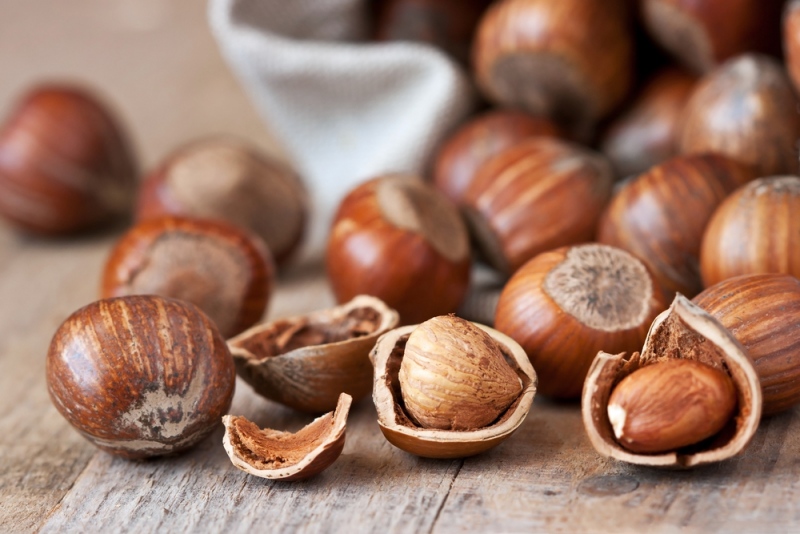Hazelnuts are perhaps most famous all over the world as the key ingredient for Nutella cocoa spread and Ferrero Rocher chocolates. Indeed, Ferrero SpA, the Italian manufacturer that concocts these two confections, is the world’s biggest consumer of hazelnuts, using 25% percent of the global supply of these nuts. Its unique flavor profile also makes it an ideal ingredient for other sweet treats like pralines and truffles, as well meringues, cakes, and candies.
Here are some more interesting facts about the hazelnut.
Turkey is the World’s Biggest Producer of Hazelnuts
Hazelnuts have a special place in Turkish cuisine, which is why it isn’t surprising the Turkey is produces nearly 75 percent, or about 561,000 metric tons, of the global supply of hazelnuts.
Hazelnut Trees Can Last for Generations
Although they are technically trees, hazelnuts are often grown as shrubs and are easy to manage in terms of size simply by regular pruning (usually done during winters). The trees grow well in drained, low-nutrient soil; rich soil often encourages leaf growth, which reduces the number and quality of flowers and nuts.
Hazelnuts can be harvested in as early as four years after planting the saplings, and can continue to produce even 50 to 100 years later. Each tree can produce anywhere between 20 to 25 pounds of hazelnuts per year of harvest.
Hazelnut is Also Called the Filbert Nut
It is believed that the name “filbert” originated from St. Philbert, whose feast day is on August 22 around which time the hazelnut harvesting season starts. Some folklorists also claim that the moniker also refers to the “full beard” covering of some long-husked hazelnut varieties. By the early 1980s, the Oregon Filbert Commission began to use the standard name “hazelnut,” as coined by the early settlers who first introduced the native species.
Hazelnut Milk is the “Nuttiest” of All Nut Milks
High-quality, cold-milled hazelnut milk has a creamy texture that is close to dairy, but flavor-wise, it has a stronger, more distinctive nutty taste compared to other nut milks like the more popular ones made from almonds or peanuts. Those used to drinking cow’s milk might take some time getting used to drinking hazelnut milk on its own. However, its unique flavor works well with coffee, chocolate milks, and dessert recipes like puddings, cream pies, pastries, and the fillings for these pastries. Hazelnuts are also used to flavor frangelico liqueurs and various non-alcoholic drinks.
Hazelnuts are Highly Nutritious
Hazelnuts are rich in B vitamins (specifically B1, B2, B6, and B9) which are essential in blood formation and nerve health, among others. They are also packed with vitamin E, a powerful antioxidant that keeps the skin and hair healthy and contributes to the health of heart muscles. Apart from these vitamins, hazelnuts are also a rich source of minerals like iron, magnesium, and phosphorus, as well as mono-unsaturated fatty acids, dietary fiber, and carbohydrates.
Hazelnut milk is also free from gluten, lactose, and soy, which makes this nut milk them a great option for those with allergies or intolerances to these substances.
Hazelnuts are Symbolic in Many Cultures
Did you know that ancient Romans gave hazelnut trees to newly-married couples as gifts and used torches made of hazelnut branches during wedding ceremonies, since it is believed that the tree ensures a long and happy relationship? On the other hand, the French believe that the plant is a symbol for fertility while Celts believe that hazel, both the tree and the nuts, gave a person wisdom.
In a small Italian town called Massaquano, hazelnuts are thrown from the roof of the Saint Lucy Chapel every December 12, the eve of St. Lucy’s feast day. According to tradition, the hazelnuts are representations of saint’s similarly colored eyes, and that St. Lucy safeguards a person’s eyesight.
There’s definitely more to the hazelnut than Nutella and chocolates. Try drinking hazelnut milk in the future, or perhaps include it in some of your dish and beverage recipes to enjoy and understand its unique flavors even more.
















